Instruments
Schubert - Erlking - Flute, Cello & Piano
 Erlkönig, Franz Schubert
Erlkönig, Franz SchubertArranged for Flute, Cello, and Piano by John W. Pratt
Piano Score and Parts for Flute and Cello; PDF $11.99
Franz Schubert (1797-1828), inspired by reading Goethe's poem, wrote his song "Erlkönig" in a few hours in 1815. The song was an immediate hit, and continues to be popular to the present day. Numerous transcriptions have been prepared, but surprisingly none that we found for flute, cello, and piano. John Pratt has created such a trio arrangement, listed here, and also a duet version of the piece with Schubert's solo part adopted without change but with a less punishing alternative to Schubert's piano accompaniment.
Excerpted from Mr. Pratt's © preface:
Piano score, 8 pages; Flute part, 2 pages; Cello part, 2 pages; Total, 20 pages.
"In the trio arrangement, the flute provides a natural voice for the child and for the mysterious Erlking, whose words are in the child's head. The cello makes a natural father. The narration is mostly given to the cello also, but the flute takes over when the child is mentioned in bars MM 24-30, and joins the cello when the ride is ending in anguish and distress (MM 139-145). The piano is treated as a member of a trio rather than an accompaniment to a voice singing words. The presence of the cello helps free the piano from the constant pounding and allows it to employ a wider range of expressive sonorities than Schubert's, befitting the absence of words. One might view the result as a kind of tone poem."
PreviewWe also offer a printed hard copy edition of Erlking for $20.38 plus a $5.95 shipping and handling fee to addresses in the USA. Please use the Contact Usform to let us know which hard copy publication(s) you would like to purchase, along with your email contact information and USPS mailing address. We will then send you a PayPal invoice for the sale and, once we receive notice from PayPal that you have paid for the item(s), we will ship your music to the address provided.
Bridge – 4 Short Pieces – Flute or Alto Flute (and Piano)
 4 Short Pieces, by Frank Bridge
4 Short Pieces, by Frank BridgeTranscribed for Flute or Alto Flute (and Piano) by J.W.Pratt
Flute Part, Alto Part, PDF $8.99
The 4 Short Pieces by Frank Bridge were written for violin and piano, and first published in 1912. As noted in John Pratt's foreword to the edition, they "provide a fine and delightful introduction to an accessible post-romantic composer who should be better known." The pieces are "Meditation", "Spring Song", "Lullaby", and "Country Dance". Mr. Pratt has created transcriptions of the violin parts for both flute and alto flute, and we include both instrument versions in this edition. We think Nos. 1 and 3 sound particularly nice on the alto flute and No. 4 is a splendid romp on the C flute, but all four are effective on either instrument, so we prefer to let our flutists decide on which instrument they choose to play each piece. We provide only our flute and alto flute transcriptions; the piano score, including the original violin part, is available as a free pdf download at imslp.org.Flute part, 5 pages; Alto Flute part, 5 pages; Total, 14 pages.
PreviewBridge – 4 More Short Pieces – Flute or Alto Flute (and Piano)
 Cradle Song, Gondoliera, Mélodie, and Elégie, by Frank Bridge
Cradle Song, Gondoliera, Mélodie, and Elégie, by Frank BridgeTranscribed for Flute or Alto Flute (and Piano) by J. W. Pratt
Preview
Flute Part, Alto Part, PDF $11.99
Like the 4 Short Pieces for Violin and Pianoforte published in transcription by Noteworthy Sheet Music earlier this year, these additional four short pieces by Bridge "provide a fine and delightful introduction to an accessible post-romantic composer who should be better known." Published by Bridge between 1903 and 1911, the works included in our second edition are transcriptions of Cradle Song, written for violin or cello and piano, Gondoliera for violin and piano, and Mélodie and Elégie for cello and piano. Mr. Pratt has created transcriptions of all four pieces for both flute and alto flute, and we include both instrument versions in this combined edition. We think Cradle Song and Elégie are particularly beautiful on the alto flute, but all are effective on either instrument, so we prefer to let our flutists decide on which instrument they choose to play each piece. We provide our flute and alto flute parts only; the original piano scores work well with our transcriptions and are available, along with the violin and cello parts, as free pdf downloads at imslp.org—click the links to access the scores for Cradle Song, Gondoliera, Mélodie, and Elégie.
Flute part, 6 pages; Alto Flute part, 6 pages; Total, 14 pages.Bloom - Ablaze She Came in the Dream - Flute, Cello, and Guitar
 Ablaze She Came in the Dream, by Peter H. Bloom
Ablaze She Came in the Dream, by Peter H. BloomContemporary Composition for Flute, Cello, and Guitar (or Electric Guitar)
Flute, Cello, & Guitar Parts, and Score, PDF $22.97
Ablaze She Came in the Dream by flutist Peter H. Bloom was scored in its original version for flute, viola, and guitar. This intriguing piece comprises eleven brief episodes, which may be repeated any number of times. It is intended to serve as an interpretive vehicle for the performers and thus should be executed freely and expressively. Ablaze received its premier performance in November, 2014, in Boston as part of the Church of the Advent Library Concert Series and featured Mr. Bloom on flute, Frank Grimes on viola, and Anastasiya Dumma on electric guitar.
In the spring of 2016, NSM received a request for a cello version of Ablaze; we complied by creating, in collaboration with the composer, an adaptation for flute, cello, and guitar. Ablaze is not only an exciting piece to hear, it's fun to play as well. Both the viola and cello editions are suitable for adventurous, advanced players. Those wishing to purchase one of our Ablaze editions and then order an additional alternative viola or cello part for a small charge should use the Contact Us form to let us know; we'll make arrangements to accommodate your request.
Score, 23 pages; Flute Part, 11 pages; Guitar Part, 12 pages; Cello Part, 12 pages; Total, 66 pages.
PreviewBeach - Ecstasy - Voice (or Afl), Alto Flute (or Cl), and Piano
 Ecstasy, Op.19 No.2, by Mrs. H. H. A. Beach
Ecstasy, Op.19 No.2, by Mrs. H. H. A. Beach
Two versions, for "Low voice (in Db)" or "High voice (in Eb)", with Alto Flute Obbligato (transcribed) and Piano.
Alternative parts for Alto Flute Solo and Bb Clarinet Obbligato.
Program Notes by Peter H. Bloom.
Piano Scores, Voice Parts, Alto Flute Obbligato Parts, and alternative Alto Flute Solo Parts and Clarinet Obbligato Parts; PDF $8.99Noteworthy Sheet Music is thrilled to publish our edition of Amy Marcy Cheney Beach's song Ecstasy in 2017, in celebration of the 150th anniversary of the composer's birth. The idea to make Ecstasy available to a broader combination of players and singers came from flutist Peter H. Bloom, who proposed that the piece would be an excellent vehicle with which instructors might inform students (early and advanced alike) about interpretation of the highly romantic late 19th century idiom. To that end, we have packaged together in a single edition Mrs. H. H. A. Beach's two versions of Ecstasy, for "low voice (in Db)" and "high voice (in Eb)", with each version including transcriptions of the obbligato (originally for violin) for either alto flute in G or clarinet in Bb, and an alternative solo part in the form of an alto flute transcription of the voice line. Thus, multiple performance variations are possible, including high or low voice and piano with either alto flute or clarinet obbligato, or fully instrumental versions for alto flute and piano, or two alto flutes and piano, or alto flute, clarinet, and piano.
Scores, 8 pages (4 pages each version); Voice parts, 2 pages (1 page each version); Alto Flute Obbligatos, 2 pages (1 page each version); Clarinet Obbligatos, 2 pages (1 page each version); Alto Flute solo parts, 2 pages (1 page each version); Total, 20 pages.
PreviewFinlayson - Moon Shadows - Winds and Percussion
 Moon Shadows, by Walter A. Finlayson
Moon Shadows, by Walter A. FinlaysonContemporary Composition for 2 Flutes, 2 Clarinets, Bass Clarinet, and 9 Percussion Instruments
Score and Parts, PDF $14.25
Walter Finlayson (1919-2000) was an American composer, musician, educator, and music innovator, with nearly twenty original compositions and some forty arrangements to his credit. While serving in the navy, he played saxophone and clarinet in the US Naval Reserve dance band, seated next to the great Artie Shaw. Finlayson's ASCAP output includes music for band, dance band, orchestra, voice, and chorus. His compositions and arrangements have been published by Boosey & Hawkes, EB Marks, Boston Music, and Mercury Music, and performed by major college marching band programs. One of his best-known compositions is I Had a Premonition, which was written for voice and piano, but which was later arranged for the Jimmie Lunceford Orchestra, one of the preeminent bands of the swing era. A recording of the tune can be heard on The Jimmie Lunceford Collection: 1930-47 compact disc released in 2014 on the Fabulous label, and on YouTube.
Noteworthy Sheet Music's chief editorial consultant Peter H. Bloom received Finlayson's previously-unpublished score for Moon Shadows from the composer's daughter, and we were impressed with its quality and sophistication. For a piece written in the late 1930's or early 1940's, as Gale Finlayson recollects (the score is not dated), Moon Shadows seems remarkably ahead of its time. The work is scored for two flutes, two clarinets, bass clarinet, bells, vibraphone, xylophone, finger cymbals, maracas, bongos, roll cymbals, temple blocks, and tympani. We notated our modern edition of the piece as faithfully as possible based on the hand-written Finlayson score; our edition of Moon Shadows includes both score and parts. We at NSM are pleased to aid in the re-discovery of some of Walter Finlayson's works; for additional information about this interesting composer, please visit the Our Composers page under About Us.
Score, 19 pages; Parts for Flute-1, Flute-2, Clarinet-1, Clarinet-2, Bass Clarinet, Bells, Vibraphone, Xylophone, Finger Cymbals and Maracas, Bongos and Roll Cymbals, Temple Blocks, and Tympani, 1 page each; Total, 34 pages.
PreviewSchumann, Clara - Three Romances - Alto Flute or Flute (and Piano)
 Three Romances, Op.22, by Clara Schumann
Three Romances, Op.22, by Clara SchumannTranscribed for Alto Flute or Flute (and Piano) by C.A.Vater
Alto Flute Part and alternative Flute Part, PDF $8.99
Clara Schumann’s Drei Romanzen für Pianoforte und Violine, Op. 22, were written in 1853 and dedicated to the Schumanns’ great friend, the famous Hungarian violin virtuoso Joseph Joachim, with whom Clara performed the Three Romances when they concertized together on tours across Europe. The Romances are lovely, short pieces; melodic and expressive, they epitomize the Romantic era and represent true chamber music in the sense that both instruments are featured comparably, rather than the piano having a merely accompaniment role. They are nicely adaptable to wind instruments, and are particularly lovely when played on alto flute. Our transcription required few modifications to bring the original violin part completely in range for alto flute and provide flute-friendly, musically-appropriate alternatives to the occasional violin double-stop. Some flutists may wish to mix and match the three movements, preferring to play one or two of the Romances on alto flute and the third on concert flute, or vice versa; so, to that end, we have included in this edition a complete alternative part adapted for C-flute. We do not provide a re-notated copy of the score, however, since high-quality PDFs of the piano and violin score are freely available in the public domain, and are easy to use along with our flute transcriptions of the violin line. To download one such PDF of the score, please visit the imslp website.
Alto Flute part, 5 pages; Flute part, 5 pages; Total 14 pages.
PreviewGlazunov - Elegy - Flute or Alto Flute
 Elegy, Op.44, by Alexander Glazunov
Elegy, Op.44, by Alexander GlazunovTranscribed for Flute or Alto Flute (and Piano) by John W. Pratt
Parts for Flute and Alto Flute, PDF $5.99
Alexander Konstantinovich Glazunov (1865-1936) was a major composer in the late Russian romantic tradition. His Elegy, Op.44, was written for viola and piano in 1893. The viola melody is readily adaptable for other instruments, since it is without double stops, and has been transcribed here by John W. Pratt for either flute or alto flute. The piece is about 6 minutes long, elegiac but not lugubrious. It consists of a lovely melody in 9/8 time, enhanced by a simple but warm piano accompaniment. The NSM edition includes a flute part and an alternative alto flute part, but does not include one for piano, since a suitable score is freely available at IMSLP.org.
Flute part, 2 pages; Alto Flute part, 2 pages; Total, 8 pages.
PreviewDanzi - Grande Sonate - Piano & Basset Horn
 Grande Sonate, Op.62, by Franz Danzi
Grande Sonate, Op.62, by Franz Danzifor Piano and Basset Horn; re-notated, edited, and with occasional ossia elaborations suggested by John W. Pratt
Piano Score and Basset Horn Part, PDF $13.99
Franz Danzi (1763-1826) was an active musician, cellist, and teacher in Mannheim, Munich, Stuttgart, and Karlsruhe. A prolific composer, especially of music for the stage and chamber music from keyboard solos to sextets, he revered Mozart and mentored Weber. His wind quintets are notable. His Grande Sonate, Opus 62, for piano and basset horn, was published about 1823, along with an alternative cello part which sometimes differs from the basset horn part in other ways than octave transposition. // The original publication of Danzi’s Opus 62 is available at imslp.org., but there is no full score and the parts are hard to play from, or sometimes even to read at all, lack measure numbers, have a few errors, and differ in the number of measures in the last two movements. We have therefore prepared a full score including the basset horn in concert pitch, to facilitate checking the fit of the basset horn and piano lines and our transcriptions for other instruments against the original. — excerpted from John Pratt’s foreword to the edition
Piano Score, 28 pages; Basset Horn part, 7 pages; Total 40 pages.
PreviewHaydn – Hob. II:21 – arr. Flute Quartet
 Divertimento No. 1 (Hob. II:21; Op. 2 No. 3) by Franz Joseph Haydn
Divertimento No. 1 (Hob. II:21; Op. 2 No. 3) by Franz Joseph HaydnArranged for Flute Quartet by John W. Pratt (originally for string quartet plus 2 horns)
Score and Parts for Flute 1, Flute 2, Alto Flute, and Bass Flute, PDF $11.97
excerpted from John W. Pratt’s © preface to the edition:
“Haydn (1732-1809) is credited with developing the classical forms of both the string quartet and the symphony, starting from the loose structures and permissive instrumentation of Baroque instrumental music. … His first string quartets are his Opus 1 Nos. 1-4 and 6, and Opus 2 Nos. 1-6, thus eleven. Opus 1 No. 5 is somewhat later, added to make a set of 6, apparently a perfect number in music publication as well as in mathematics. Opus 2 Nos. 3 and 5 are quartet arrangements of two divertimentos including also two horns and listed in the Hoboken catalogue as II:21 and 22 … The spirit and spiritedness of the two divertimentos suit them to flute quartet, as does the distribution of activity. In addition, a flute quartet combines the unified timbre of a string quartet with the wind sound of the horns, while the early string quartets do not exploit the string sound per se. Transposition up a step puts the cello and viola parts of Hob. II:21 mostly within the bass and alto flute ranges and makes the violin parts if anything more comfortable for C flutes.”
There are 5 movements in total: I-Allegro molto, II-Minuet, III-Adagio, IV-Minuet, and V-Finale Allegro. To get some sense of how the Op. 2 No. 3 quartet works with flutes in lieu of strings, listen to this computer-generated audio clip of the first movement—realizing it will of course sound considerably better played in-person on real instruments, post-pandemic.
Score, 11 pages; Flute 1 part, 6 pages; Flute 2 part, 6 pages; Alto Flute part, 5 pages; Bass Flute part, 5 pages; Total, 38 pages.
PreviewHaydn – Hob. II:22 – arr. Flute Quartet
 Divertimento No. 2 (Hob. II:22; Op.2, No.5) by Franz Joseph Haydn
Divertimento No. 2 (Hob. II:22; Op.2, No.5) by Franz Joseph HaydnArranged for Flute Quartet by John W. Pratt (originally for string quartet plus 2 horns)
Score and Parts for Flute 1, Flute 2, Alto Flute, and Bass Flute, PDF $10.97
This is the second of Haydn’s two divertimenti, Hob. II:21 and II:22, that John Pratt has arranged for flute quartet, scored for two C-flutes, alto flute, and bass flute. Both divertimenti were written originally for string quartet plus two horns, but were later adapted by others as quartet-only versions identified as Opus 2, No.3 and No.5. Please see the text excerpted from Mr. Pratt’s preface to his arrangement of Haydn’s Divertimento No.1 (Op.2, No.3) for additional information that applies to both these works. There are 5 movements in Op.2, No.5: I-Presto, II-Minuet, III-Largo, IV-Minuet, and V-Finale Presto. Listen to this computer-generated audio clip from the second movement Minuet to get a sense of how the quartet sounds with flutes in lieu of strings.
Score, 10 pages; Flute 1 part, 4 pages; Flute 2 part, 4 pages; Alto Flute part, 4 pages; Bass Flute part, 3 pages; Total, 28 pages.
PreviewHaydn – Adagio from Symphony No.24 – trans. Solo Flute and Flute Choir
 Adagio from Symphony No.24 by F. J. Haydn
Adagio from Symphony No.24 by F. J. HaydnTranscribed for Solo Flute accompanied by Flute Choir, by John W. Pratt (originally for flute and strings)
Score and Parts for Solo Flute, Flutes 1 and 2, Alto Flute, and Bass Flute/Contrabass Flute, PDF $7.99
Haydn wrote his Symphony No.24 in 1764. Its second movement is a beautiful Adagio for flute solo accompanied by strings. The string parts are simple, with no double stops or extreme high notes, so they can be played comfortably by corresponding members of the flute family, except for a few low notes. This transcription for flute choir is therefore straightforward except that the alto flute sometimes plays violin notes that C-flutes cannot play or can use support playing, and similarly the bass flute plays some viola notes instead of or in addition to the alto flute playing them. Notes taken from the cello in its lowest octave have been raised an octave for bass flute, but there are fewer than one might expect. Perhaps one reason is that Haydn expected a (string) bass to be doubling the cello an octave lower, playing from the same part. If a contrabass flute is available, it can double the bass flute similarly, serving even more to enrich the sound. —adapted from JWP’s preface to the edition
Listen to a computer-generated audio sample.
Score, 5 pages; Parts for Solo Flute, 2 pages; Flutes 1 and 2, 2 pages; Alto Flute, 1 page; Bass Flute/Contrabass Flute, 1 page; Total 19 pages.
PreviewDvořák - Romance, Op. 11 - arr. for Flute Choir
 Romance, Op. 11 by Antonín Dvořák
Romance, Op. 11 by Antonín DvořákArranged for Solo Flute and Flute Choir by C. A. Vater (originally for solo violin and orchestra)
Score and Parts for Solo Concert Flute, 4 Concert Flutes, 2 Alto Flutes, 2 Bass Flutes, and 1 Contrabass Flute, PDF $21.97
Czech composer Antonín Dvořák based his Romance, Opus 11 on the slow movement of his String Quartet in F minor, composed in 1873, re-working that Andante con moto quasi allegretto to create two versions of the Romance, one for solo violin and orchestra (B.39) and another for solo violin and piano (B.38). The Romance is one of Dvořák’s most magnificent melodic works, teaming with romance, lyricism, and emotional intensity. I created a solo flute version of this piece for my personal use, and I so enjoyed playing it that I shared it with a flutist friend / NSM editorial consultant, who suggested that the Romance might be nicely adaptable for flute choir. I took on that challenge and created this arrangement, scored for flute solo with the accompaniment of four concert flutes, two alto flutes, two bass flutes, and one contrabass flute. A few changes have been incorporated in the solo part, bringing the violin’s lowest notes into concert flute range and providing appropriate alternatives to the occasional double stops. Likewise, the various string and wind parts created by Dvořák for his orchestral arrangement (available on IMSLP.org) have been modified in places to suit members of the flute family. Of course, any work played by a flute choir will sound very different than when played by an orchestra, but in arranging this piece for flute choir, every effort has been made to maintain the spirit, character, balance, and flow of Dvořák’s exquisite Romance.
The parts in our edition have been formatted for convenient page turns when the complete PDF is printed 2-sided in its entirety. If a more compact version of the score is desired, however, please select a “2 pages per sheet” printer option for the score and print the score pages separately from the parts.
Score, 60 pages; Solo Flute part, 4 pages of music; Flutes 1-4 parts, each 3 pages of music; Alto Flute 1 part, 4 pages of music; Alto Flute 2 part, 3 pages of music; Contrabass Flute part, 3 pages of music; Total, 104 pages.
PreviewElgar – Mot d’Amour – Alto Flute & Piano
 Mot d’Amour, Op.13, No.1, by Edward Elgar
Mot d’Amour, Op.13, No.1, by Edward ElgarTranscribed for Alto Flute and Piano by C. A. Vater
Piano Score and Part for Alto Flute, PDF $5.49
In 1888, Elgar composed Salut d’Amour, now one of his most-recognized pieces, as an engagement gift for his beloved fiancée. Later he wrote Mot d'Amour (Love's Word) for violin and piano as a companion piece to Salut d’Amour. Mot d'Amour, which was initially given the German title Liebesahnung, was published in 1889 by Osborn & Tuckwood in the edition 2 Pieces for Violin & Piano that included this piece and a second one, less well-suited to alto flute, called Bizarrerie. Mot d’Amour is similar to Salut d’Amour in being light, charming, and highly romantic. Although Mot d’Amour never attained the level of popularity achieved by the earlier work, it is considered by some to be the finer composition (https://www.elgar.org/3salut.htm). Both Salut d’Amourand Mot d'Amoursound especially rich and mellow when performed on alto flute, and both pieces are now available from Noteworthy Sheet Music as transcriptions for alto flute and piano, adapted from the composer’s violin and piano editions now in the public domain and available on imslp.org.
Score, 4 pages; Alto Flute part, 1 page; Total, 8 pages.
Burleigh - Southland Sketches, Nos. I, III, IV - Alto Flute or Flute (& piano)
 Southland Sketches, Nos. I, III, IV, by H. T. Burleigh
Southland Sketches, Nos. I, III, IV, by H. T. BurleighTranscribed for Alto Flute or Flute (and piano) by C. A. Vater
Alto Flute part and Flute part, PDF $9.96
Harry Thacker Burleigh was an acclaimed African-American singer, music editor, and composer whose adaptations of African-American spirituals became famous. His Southland Sketches, which were composed for violin and piano and published by G. Ricordi in 1916, are a fine example of Burleigh’s quintessential American style. The original composition included 4 movements. Our edition excludes the second movement, but adapts three of the original four miniatures for either alto flute or flute. We provide only the transcribed alto flute and flute parts, as they have been designed to work well with the piano part in the original score for violin and piano which is available as a good quality, free pdf download from imslp.org. Performers may choose to play all three of these pieces on either flute or alto flute, or switch instruments between sketches, depending on personal preference.
Alto Flute part, 6 pages; alternate Flute part, 6 pages; Total,18 pages. (pdf of piano accompaniment is freely available at imslp.org)
Preview
Bach - Adagio and Fugue from BWV 564 – arr. Flute Quartet
 Adagio and Fugue from BWV 564, by J. S. Bach
Adagio and Fugue from BWV 564, by J. S. BachArranged for Flute Quartet by John W. Pratt
Score and Parts for Flute 1, Flute 2, Alto Flute, and Bass Flute, PDF $21.25
Among J. S. Bach's big organ works, the Toccata, Adagio, and Fugue, BWV 564 is atypical in ways that make it especially adaptable to transcription for winds, as we noted when transcribing it for woodwind quartet. The middle movement Adagio has an elaborate and gorgeous melody which lies comfortably for flute and can benefit greatly from the shaded, nuanced dynamics and articulations that a solo flutist can provide. The four-part Fugue is unusual, too—light and lighthearted, happily adaptable to woodwinds. The Adagio and Fugue are particularly well-suited to a flute quartet and these (but not the Toccata) are included in John Pratt’s arrangement of the piece for two flutes, alto flute and bass flute. Note that the score is presented with the alto flute line in concert pitch and the bass flute line shown in bass clef so as to easily see the range of all the flutes' notes; in the parts, of course, the alto flute is transposed and the bass flute is in treble clef.
Score, 10 pages; Flute 1 part, 4 pages; Flute 2 part, 3 pages; Alto Flute part, 3 pages; Bass Flute part, 2 pages; Total, 30 pages.
Preview
Bowlby - Laurels - Flute
 Laurels, by Timothy J. Bowlby
Laurels, by Timothy J. BowlbyContemporary Composition for Solo Flutist, playing flute, alto flute, and piccolo, PDF $9.00
—adapted from excerpts of program notes written by the composer, Timothy J. Bowlby:Laurels, for solo flutist playing flute, alto flute, and piccolo, was written in 2018 for two of the composer’s flutist colleagues, Laurel Tempas and Peter H. Bloom. The piece is cast in a three-section form. The flute is featured exclusively in the initially march-like A section of the work. A “lyrical alto flute passage”, requested by Mr. Bloom, starts the middle or B section and the piccolo concludes it; the overall affect is one of contemplation and reflection in nature. The concluding A’ portion is begun by the piccolo and ends with a return to the flute and the march-like material that started the piece.Laurels was premiered by Peter H. Bloom in June, 2019; a recording of the performance can be accessed on YouTube at https://www.youtube.com/watch?v=e8s4Gos2lE8.Flute part, 5 pages of music; Total, 8 pages.
PreviewThe lovely cover image used for our Laurels edition is courtesy of wikiwand.com, Kalmia latifolia, the mountain laurel, calico bush, or spoonwood, image of flower buds. Attribution-ShareAlike 1.0 Generic (CC BY-SA 1.0). The image has been cropped, enlarged and sharpened.Haydn – Symphony 13 - arr. for Multiple Flutes
 Symphony 13, by Franz Joseph Haydn
Symphony 13, by Franz Joseph HaydnArranged for Multiple Flutes by John W. Pratt
Score and Parts for Flutes 1-4, Alto Flute, Bass Flute; PDF $23.95
This arrangement of Haydn’s Symphony No.13 is for a flute ensemble of any size including at least one bass, one alto, and two concert flutes. Third and fourth concert flute parts are also provided, and all parts can be doubled at will. If a contrabass flute is available, it can double the bass flute, serving to deepen and enrich the sound. The second movement is a beautiful Adagio cantabile, originally for solo cello accompanied by strings, which transcribes nicely for alto flute accompanied by the rest of the flute family. The trio of the symphony’s third movement has a delightful solo flute part with only string accompaniment. A large flute ensemble would be about the size of Haydn’s core orchestra at the time this symphony was composed; in our arrangement, Haydn’s original key has been raised a minor third to better suit the natural range of a flute ensemble.
Score, 17 pages; separate parts for Flute 1, Flute 2, Flute 3, and Flute 4, 6 pages each; Alto Flute part, 7 pages; Bass Flute part, 6 pages; Total, 68 pages.
Preview
Haydn - Op.1, No.1- arr. Flute Quartet
 Quartet, Op.1, No.1, by Franz Joseph Haydn
Quartet, Op.1, No.1, by Franz Joseph HaydnArranged for Flute Quartet by John W. Pratt (originally for strings)
Score and Parts for Flute 1, Flute 2, Alto Flute, and Bass Flute, PDF $15.99
The earliest quartets of Franz Joseph Haydn are not precursors of the later works wherein he developed the form and style of the classical string quartet, but rather divertimenti written for four friends when he was about 25. Most of these early works have five movements: fast, minuet/trio, slow, minuet/trio, fast; and their slow movements feature beautiful, elaborate, gently accompanied melodies.
The divertimento style and instrumental character of these early pieces does not evoke strings specifically or necessarily, and thus arrangement for other instruments is natural and might expand enjoyment of these wonderful first significant Haydn works to other players and audiences. In John Pratt’s arrangement of Haydn’s Op.1, No.1 (Hob.III:1), most of the range issues for flutes were solved by transposition up a step, a few more by exchanging the two inner voices in places or by octave transpositions. This lovely, effective arrangement is for a flute quartet consisting of two concert flutes, alto flute, and bass flute; the edition is available exclusively from Noteworthy Sheet Music.
Score, 19 pages; Parts for Flute 1, Flute 2, Alto Flute and Bass Flute, 5 pages each; Total, 46 pages.
Preview
Brahms - Two Songs, Op.91 - Clarinet
 Two Songs, Op.91, by Johannes Brahms
Two Songs, Op.91, by Johannes BrahmsTranscribed for Clarinet by John W. Pratt (part originally for viola)
Clarinet Part, PDF $6.99
The two chamber music songs of Brahms' Zwei Gesänge, Op.91 were composed specifically for his dear friends, the violinist/violist Joseph Joachim and the mezzo-soprano Amalie Schneeweiss, who were married in 1863. The songs (for alto, viola, and piano) were written over 20 years apart, but Brahms published them together as Op.91 in 1884.
"Gestillte Sehnsucht", which appears first in the Op.91 pairing, was actually written second, in 1884. The song sets the text of the poem by Friedrich Rückert (1788-1866). "Gestillte Sehnsucht" is a nature poem, filled with images of forests at sunset, gentle breezes, and twittering birds. Rückert is famous not only for his exquisite poems themselves but also for the great inspiration his work provided to numerous prominent composers, in addition to Brahms. "Geistliches Wiegenlied" (Sacred Cradle Song) was first composed in 1863-1864, and later revised. The viola opens with the melody of the medieval Christmas carol "Joseph, lieber Joseph mein." The singer has her own variation of the melody, and enters after the first stanza of the viola's carol. The song is a beautiful cradle-rocking lullaby, in 6/8 time.
It is said that the viola was Brahms' favorite stringed instrument, and the composer gave the viola a major role in both of these songs, allowing it to open both pieces before the singer enters. Clarinetists have long coveted these viola parts, and various performances have provided clear evidence that a successful outcome can be achieved with the substitution of a clarinet for the viola in Op.91. So when a clarinetist friend of ours asked us to create a transcription for him, we gladly obliged. Our edition of the clarinet part adapts the first song, "Gestillte Sehnsucht", for clarinet in A, and the second, "Geistliches Wiegenlied", for clarinet in Bb. The original piano score and voice part are in the public domain, readily available as free PDF downloads from IMSLP.org.
Clarinet part, 4 pages; Total, 8 pages.
Preview
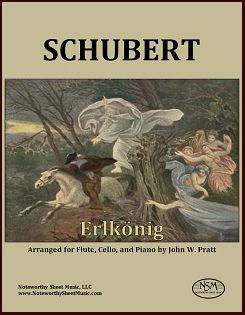 Erlkönig, Franz Schubert
Erlkönig, Franz Schubert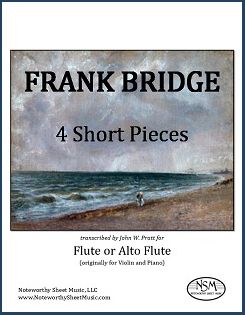 4 Short Pieces, by Frank Bridge
4 Short Pieces, by Frank Bridge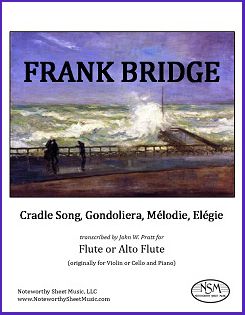 Cradle Song, Gondoliera, Mélodie, and Elégie, by Frank Bridge
Cradle Song, Gondoliera, Mélodie, and Elégie, by Frank Bridge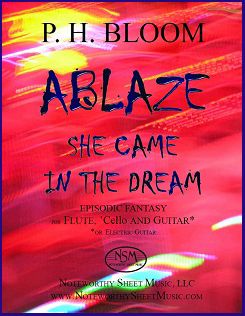 Ablaze She Came in the Dream, by Peter H. Bloom
Ablaze She Came in the Dream, by Peter H. Bloom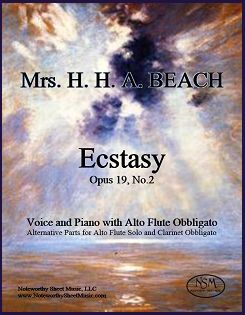 Ecstasy, Op.19 No.2, by Mrs. H. H. A. Beach
Ecstasy, Op.19 No.2, by Mrs. H. H. A. Beach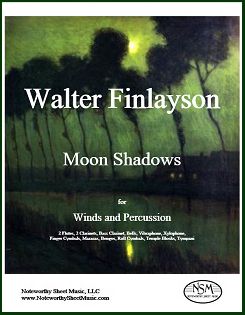 Moon Shadows, by Walter A. Finlayson
Moon Shadows, by Walter A. Finlayson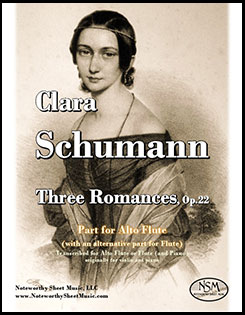 Three Romances, Op.22, by Clara Schumann
Three Romances, Op.22, by Clara Schumann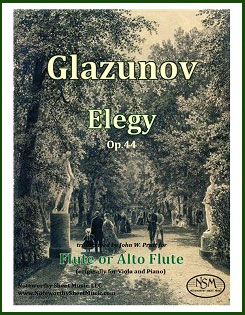 Elegy, Op.44, by Alexander Glazunov
Elegy, Op.44, by Alexander Glazunov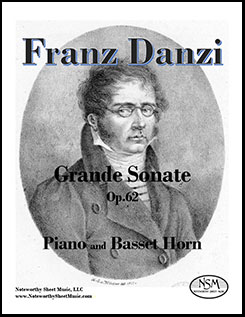 Grande Sonate, Op.62, by Franz Danzi
Grande Sonate, Op.62, by Franz Danzi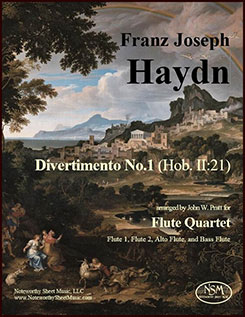
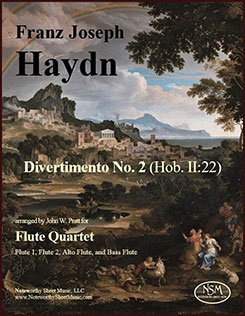 Divertimento No. 2 (Hob. II:22; Op.2, No.5) by Franz Joseph Haydn
Divertimento No. 2 (Hob. II:22; Op.2, No.5) by Franz Joseph Haydn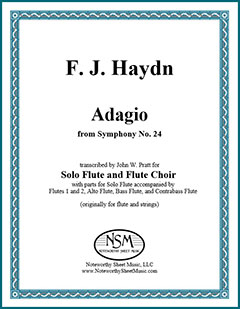
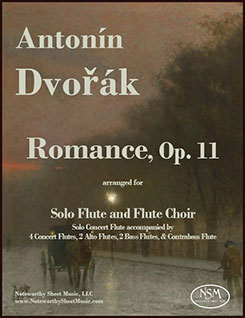 Romance, Op. 11 by Antonín Dvořák
Romance, Op. 11 by Antonín Dvořák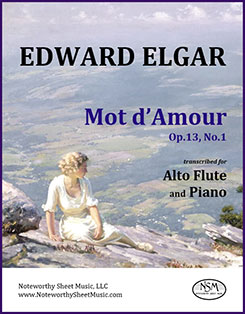 Mot d’Amour, Op.13, No.1, by Edward Elgar
Mot d’Amour, Op.13, No.1, by Edward Elgar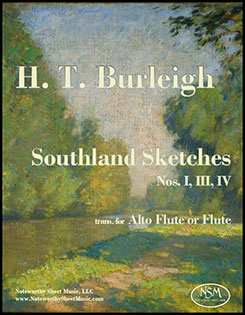 Southland Sketches, Nos. I, III, IV, by H. T. Burleigh
Southland Sketches, Nos. I, III, IV, by H. T. Burleigh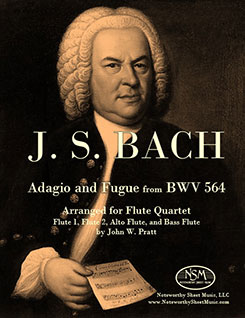 Adagio and Fugue from BWV 564, by J. S. Bach
Adagio and Fugue from BWV 564, by J. S. Bach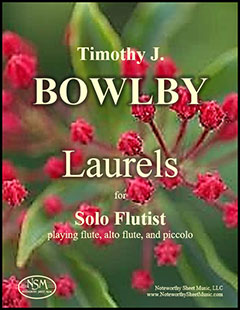
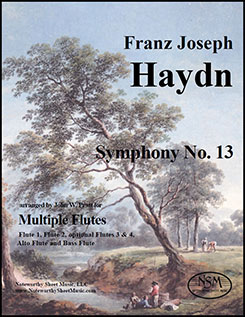 Symphony 13, by Franz Joseph Haydn
Symphony 13, by Franz Joseph Haydn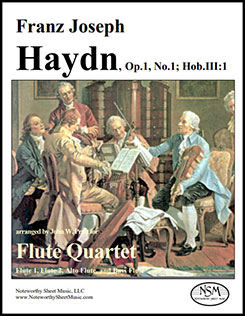 Quartet, Op.1, No.1, by Franz Joseph Haydn
Quartet, Op.1, No.1, by Franz Joseph Haydn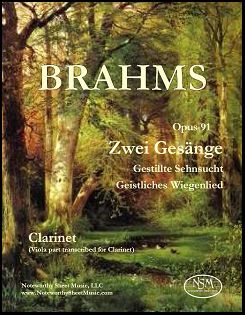 Two Songs, Op.91, by Johannes Brahms
Two Songs, Op.91, by Johannes Brahms